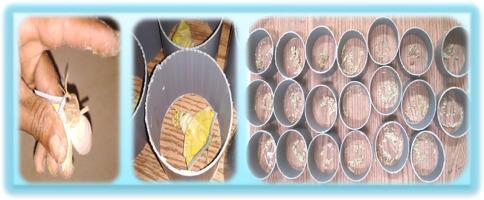Journal of Asia-Pacific Entomology ( IF 1.5 ) Pub Date : 2021-07-28 , DOI: 10.1016/j.aspen.2021.07.021 Soundappan S Mohanraj 1 , Dinesh Kumar 2 , M.V.K. Bhagavanulu 3 , M. Chandrashekharaiah 4 , M.S. Rathore 4 , C. Srinivas 5

|
Antheraea mylitta Drury (Lepidoptera: Saturniidae) is a tropical semi-domesticated wild tasar silkworm reared by marginal tribal farmers of India. Due to improper egg laying frequency, oviposition is generally kept for three continuous days after amputating the gravid moth wings (W–) in earthen cups (C). In order to systematize the oviposition frequency, wing cut with leg cut (W–L–) was performed in ecorace Daba trivoltine (DTV) completing three life-cycles in a year. Oviposition of (C)W–L– was observed in all three grainages during the year 2020 and compared with (C)W– moths. Oviposition was also accomplished on plain paper sheets (S). It is observed that (C)W– obtained 63–67% and (C)W–L– obtained 72–80% egg laying on first day. Similarly, (S)W– and (S)W–L– obtained 68–71% and 74–83% on first day. Further, significant high oviposition was observed within first four hours in both earthen cups and on paper sheets by W–L– moths laying 49–69% and 55–65% eggs compared to W– laying 25–45% and 39–44% eggs, respectively. A total of 44–51, 47–54, 44–48 and 46–52 eggs/g moth weight was obtained in (C)W–, (C)W–L–, (S)W– and (S)W–L–, respectively in three consecutive grainage. Oviposition of W– moths in earthen cups and on paper sheets are not significantly different indicating earthen cups in contemporary tasar grainage could be replaced with paper sheets. Thus, the paper demonstrates for the first time a fast, efficient and scalable cellular oviposition of A. mylitta on paper sheets comparable to Bombyx mori.
中文翻译:

翅和腿截肢在产卵装置中诱导热带 tasar 丝蛾 Antheraea mylitta Drury(鳞翅目:Saturniidae)的产卵模式——土杯和纸
Antheraea mylitta Drury(鳞翅目:Saturniidae)是一种热带半驯化的野生泰萨蚕,由印度的边缘部落农民饲养。由于产卵频率不当,通常在土杯(C)中切除妊娠蛾的翅膀(W -)后,连续产卵3天。为了使产卵频率系统化,在 Ecorace Daba trivoltine (DTV) 中进行了切翼和切腿 (W – L – ),在一年内完成了三个生命周期。在 2020 年的所有三个谷物中都观察到了 (C)W – L – 的产卵,并与 (C)W –飞蛾进行了比较。产卵也可在普通纸片 (S) 上完成。据观察,(C)W–获得 63–67% 和 (C)W – L –在第一天获得 72–80% 的产卵。同样,(S)W –和 (S)W – L –在第一天获得了 68-71% 和 74-83%。此外,在前四小时内,W – L –飞蛾在土杯和纸张上观察到明显的高产卵量,W – L –产卵 49–69% 和 55–65%,而 W –产卵 25–45% 和 39–44%鸡蛋,分别。在 (C)W –、(C)W – L –、(S)W –和 (S)W 中获得了总共 44–51、47–54、44–48 和 46–52 个卵/g 蛾重– L –,分别在三个连续的粮仓中。W 的产卵-陶杯和纸张上的飞蛾没有显着差异,表明当代 tasar 纹理的陶杯可以用纸张代替。因此,该论文首次展示了与家蚕相似的A. mylitta在纸张上的快速、高效和可扩展的细胞产卵。



























 京公网安备 11010802027423号
京公网安备 11010802027423号